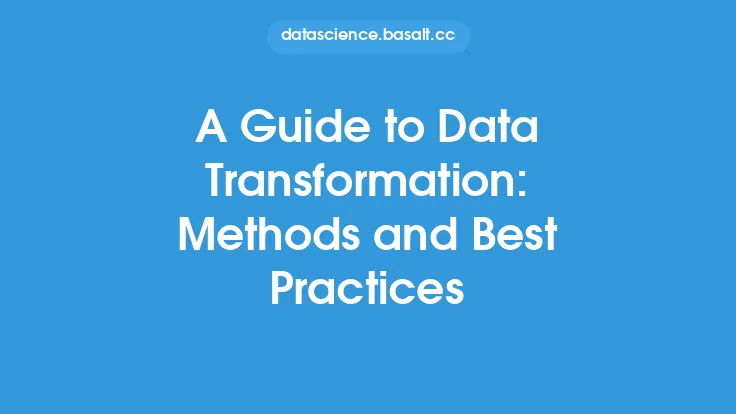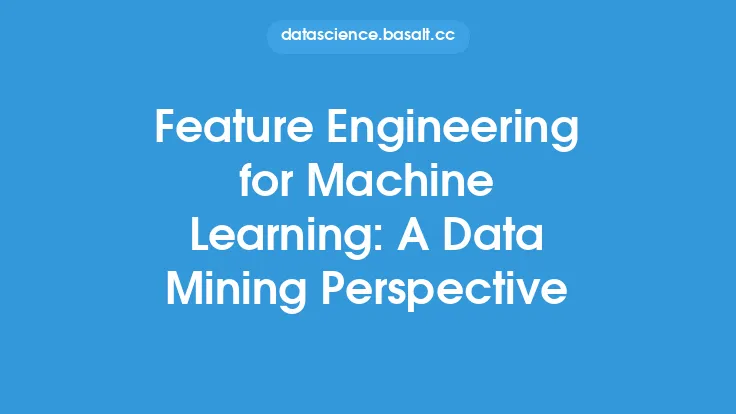Data transformation is a crucial step in the data analysis process, particularly when it comes to feature engineering. It involves converting raw data into a suitable format that can be used to train machine learning models or perform statistical analysis. The goal of data transformation is to improve the quality and relevance of the data, making it more suitable for modeling and analysis. In this article, we will discuss the best practices for data transformation in feature engineering, highlighting the key techniques and considerations that data analysts and scientists should keep in mind.
Introduction to Feature Engineering
Feature engineering is the process of selecting and transforming raw data into features that are more suitable for modeling. It involves using domain knowledge and expertise to create new features that are relevant to the problem being solved. Feature engineering is a critical step in the machine learning pipeline, as it can significantly impact the performance of the model. Data transformation is a key component of feature engineering, as it enables the creation of new features that can improve the accuracy and robustness of the model.
Types of Data Transformation
There are several types of data transformation that can be used in feature engineering, including:
- Scaling: Scaling involves transforming the data to have a specific range or distribution. This can be useful for algorithms that are sensitive to the scale of the data, such as neural networks.
- Encoding: Encoding involves transforming categorical data into a numerical format that can be used by machine learning algorithms. This can be useful for algorithms that are not designed to handle categorical data, such as linear regression.
- Aggregation: Aggregation involves combining multiple features into a single feature. This can be useful for reducing the dimensionality of the data and improving the performance of the model.
- Transformation: Transformation involves applying a mathematical function to the data to change its distribution or shape. This can be useful for stabilizing the variance of the data or making it more normal.
Best Practices for Data Transformation
When performing data transformation, there are several best practices that data analysts and scientists should keep in mind. These include:
- Understand the data: Before performing any data transformation, it is essential to understand the distribution and characteristics of the data. This can involve visualizing the data, calculating summary statistics, and checking for missing values.
- Choose the right transformation: The choice of data transformation will depend on the specific problem being solved and the characteristics of the data. For example, if the data is skewed, a logarithmic transformation may be useful for stabilizing the variance.
- Evaluate the transformation: After performing a data transformation, it is essential to evaluate its effectiveness. This can involve visualizing the transformed data, calculating summary statistics, and checking for any changes in the distribution or shape of the data.
- Consider the impact on the model: Data transformation can have a significant impact on the performance of the model. For example, scaling the data can improve the performance of neural networks, while encoding categorical data can improve the performance of linear regression.
Common Data Transformation Techniques
There are several common data transformation techniques that are used in feature engineering, including:
- Standardization: Standardization involves transforming the data to have a mean of 0 and a standard deviation of 1. This can be useful for algorithms that are sensitive to the scale of the data, such as neural networks.
- Normalization: Normalization involves transforming the data to have a specific range, such as between 0 and 1. This can be useful for algorithms that are sensitive to the scale of the data, such as decision trees.
- Log transformation: Log transformation involves applying the logarithm function to the data. This can be useful for stabilizing the variance of the data and making it more normal.
- One-hot encoding: One-hot encoding involves transforming categorical data into a binary format. This can be useful for algorithms that are not designed to handle categorical data, such as linear regression.
Handling Missing Values
Missing values are a common problem in data analysis, and can have a significant impact on the performance of the model. There are several techniques that can be used to handle missing values, including:
- Imputation: Imputation involves replacing missing values with a specific value, such as the mean or median of the data.
- Interpolation: Interpolation involves estimating missing values based on the surrounding data.
- Extrapolation: Extrapolation involves estimating missing values based on the overall trend of the data.
- Listwise deletion: Listwise deletion involves deleting any rows or columns that contain missing values.
Evaluating the Effectiveness of Data Transformation
Evaluating the effectiveness of data transformation is critical to ensuring that the transformation is improving the quality and relevance of the data. There are several techniques that can be used to evaluate the effectiveness of data transformation, including:
- Visual inspection: Visual inspection involves visualizing the transformed data to check for any changes in the distribution or shape of the data.
- Summary statistics: Summary statistics involve calculating metrics such as the mean, median, and standard deviation of the transformed data.
- Model performance: Model performance involves evaluating the performance of the model on the transformed data, using metrics such as accuracy, precision, and recall.
- Cross-validation: Cross-validation involves evaluating the performance of the model on a holdout set, to ensure that the transformation is not overfitting to the training data.
Conclusion
Data transformation is a critical step in feature engineering, and can have a significant impact on the performance of the model. By understanding the different types of data transformation, choosing the right transformation, and evaluating its effectiveness, data analysts and scientists can improve the quality and relevance of the data, and build more accurate and robust models. Whether it's scaling, encoding, aggregating, or transforming the data, the key is to use domain knowledge and expertise to create new features that are relevant to the problem being solved. By following best practices and using common data transformation techniques, data analysts and scientists can unlock the full potential of their data, and build models that drive business value and insights.





